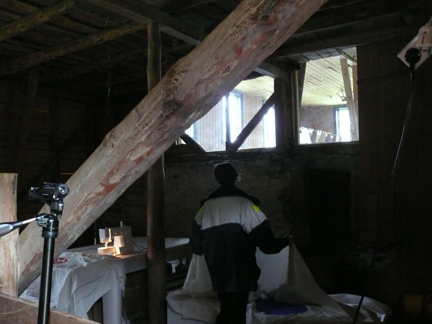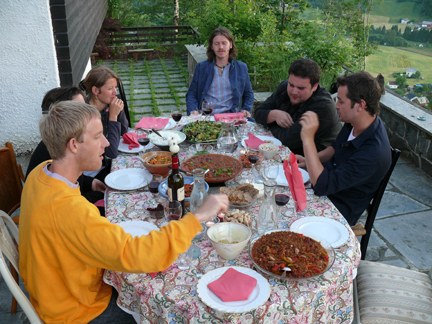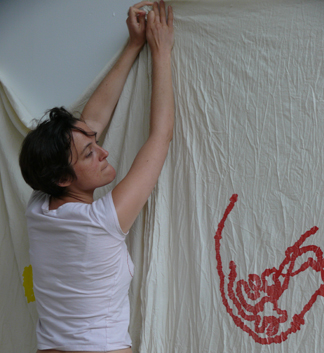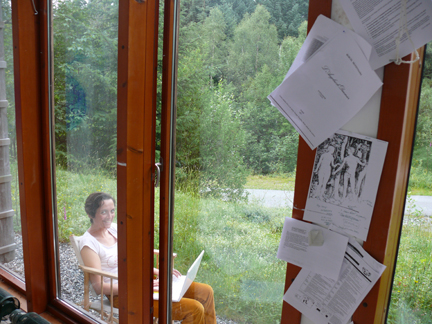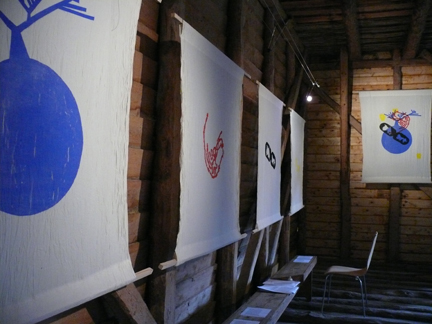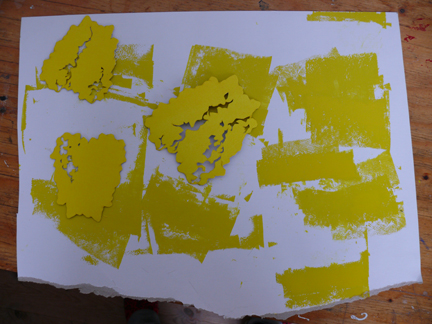Garden of Eden
Acknowledgements:
nkd Norway and Aamot Gaarde for a beautiful artist residency in Dale i Sunnfjord, Norway. Cornell Council for the Art for funding to support the initial solicitation for Visualizing Meaning.
Butterfly kisses to Elisabet Gunnarsdottir and Justina Brazaite for support and lovely moments.
View from Aamot Gaarde Barn Gallery (Photo by Justina Brazaite)
Blue (Tree of Knowledge): In 1980, the journal Science published a famous paper by Carl Woese. It depicted a cladogram, a tree of evolution that organized different organisms based on the similarity/difference of their DNA sequences. Blue depicts a stylized version of a later version of his diagram. Each branch represents major groups of organisms. It should be noted the 2 left most major branches are bacteria. The right-most branch includes animals, fungi and plants to name a few. Two similar diagrams were selected by Dan Buckley (Department of Crop and Soil Science) and Stephen Zinder (Department of Microbiology).
Collograph, relief printing ink on cotton muslin. R Domeij Printing Press, Stockholm.
115 cm w x 125 cm h Bygstad, Norway, August 2007
This piece was first shown opposite and installation by Michael Johannson in the barn galleries of Åmot Gaard for the opera weekend.
From the Visualizing Meaning Project, four scientific images were combined as collographs in primary colors for a molecular interpretation of genesis.
Blue (Evolutionary Tree of Knowledge)
Red (DNA Snake)
Black (Bacterial Adam and Eve)
Yellow (Ion Transport Apple)
In the garden (Photo by Justina Brazaite)
Installation Image (Photo by Justina Brazaite)
Ion Transport Channel Collograph Templates (Photo by Justina Brazaite)
Yellow (The Apple): This is an image of a protein called an ion transport channel published in Science in 1998. These channels span cell membranes and set up ion gradients inside or outside a cell. Imagine pumping a bunch of positively charged potassium ions (high concentration in bananas) across a membrane so there is more potassium outside the cell than inside. Given some stimulus, the ports open and the potassium floods inside the cell. The change in the concentration of potassium inside the cell then stimulates a cascade of other events. In sum, the evolution of this miraculous protein is responsible for so much of what we call life - from muscles contracting, to memory to sensing the environment. In a way, the ion transport channel is the originator of the allegory, without it, we would have no thought, and therefore no allegory, so indeed, it opened pandoras box. This image was submitted by Carl Hopkins (Department of Neurobiology and Behavior).
See Also the portrait of the ion transport channel in the Hierarchy of Genres series.
nkd Studio (Photo by Justina Brazaite)
Black (Adam and Eve): This is a stylized image of a bacteria dividing as seen by Transmission Electron Microscopy. This image was suggested by Esther Angert (Department of Microbiology) upon request. Bacteria are amazing organisms responsible for creating our livable atmosphere, helping us digest food and cleaning our skin. They also help break down materials so the nutrients can be easily absorbed by living organisms. It blows my mind how a single bacteria could have evolved, say nothing of how it divided before it died. It is an awesome moment in history. It is likely that bacteria or something similar is our oldest ancestor (LUCA, last universal common ancestor).
View of Barn Gallery from the Opera Performance Space (Photo by Justina Brazaite)
Red (The Snake): This image of DNA was from John Lis (Department of Molecular Biology and Genetics). It depicts the active genes being expressed in DNA as visualized by a labeling technique called Immunofluorescence microscopy. This snake speaks in ctgaatcccta, the basic building blocks or nucleotides of DNA that spell out the genetic coding for all living organisms. The distance between branches (groups of similar organisms) in blue is a depiction of the measured difference in the sequence of these letters. These letters encode the sequence for proteins such as Yellow. One stripe in this snake represents a whole slew of nucleotide sequences that account for one such gene.
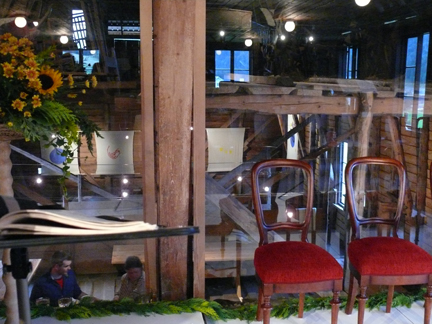
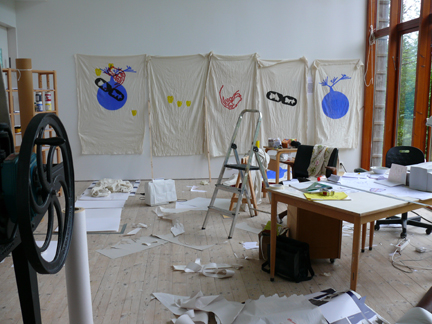
Garden Details
